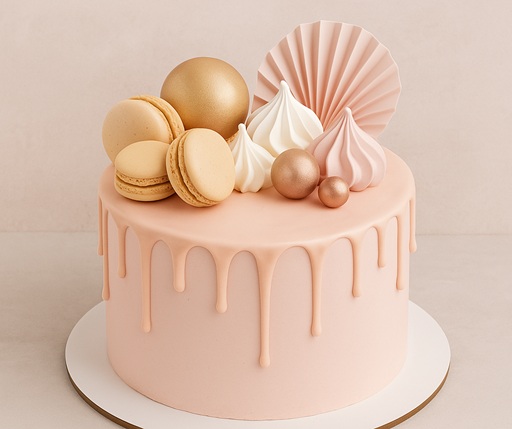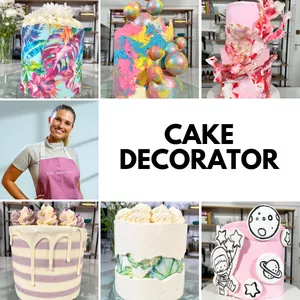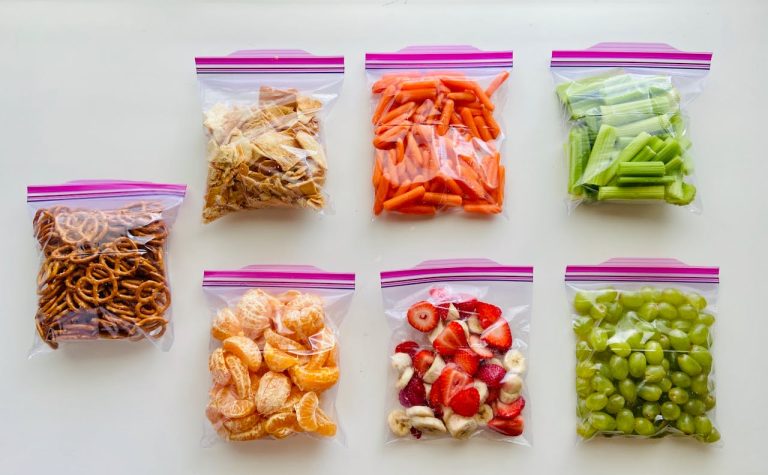Cake Decorating
Cake decorating has evolved significantly in modern pastry making, becoming an essential aspect for those seeking not only to satisfy their palates but also to create memorable experiences. The visual presentation of a cake can transform any celebration, elevating its relevance during special events such as weddings, birthdays, and festivities. The decoration should not only be attractive but also communicate a message or theme that resonates with attendees, so paying attention to this practice is crucial.
Furthermore, in the digital age, the importance of eye-catching decoration has become even more prominent thanks to the rise of social media. Platforms like Instagram and Pinterest have created a visual culture where the most elaborate and aesthetically pleasing cakes tend to attract more attention. Photos of beautifully decorated desserts are widely shared, driving demand for innovative and creative techniques. Bakers, therefore, are incentivized to hone their decorating skills to stand out in a competitive market and satisfy an increasingly demanding audience.
The impact that good cake decoration can have on the customer experience should not be underestimated. A well-decorated cake can serve as a focal point, sparking conversations and memories that last a lifetime. Whether through the use of fondant, icing, or modeling techniques, the process of decorating a cake goes beyond mere aesthetics; it’s an art form that combines creativity, skill, and knowledge. Cake decorating is, therefore, an indispensable aspect of modern baking, one that deserves to be explored and celebrated.
Fundamental Principles of Cake Decorating
Cake decorating is an art that combines creativity and technique, and there are fundamental principles that every decorator must master to achieve impressive results. One of the most important aspects is color theory. Colors not only affect the appearance of a cake but also evoke emotions and sensations. Choosing a harmonious color palette can transform a simple cake into a visual masterpiece. Therefore, it is essential to consider how the colors will complement each other and how the desired message can influence the color choice.
Symmetry and balance are two other key principles in cake decorating. Symmetry refers to the balanced arrangement of elements, which can be visually appealing and pleasing to the eye. On the other hand, balance involves distributing decorative elements so that the cake doesn’t feel heavy or disproportionate in any one area. A cake can be symmetrical in shape and decoration, or it can take a more asymmetrical approach, as long as the visual balance is maintained.
The use of space in the decoration also deserves attention. A well-thought-out design should consider the available space on the cake’s surface, avoiding an overload of details that could overwhelm the eye. Negative space, or undecorated areas, can be equally effective and help highlight the design’s main features.
Finally, the choice of materials is crucial to complementing the cake’s overall design. From the frosting to the edible decorations, each element must be carefully selected and in keeping with the desired style. Considering the texture, color, and interaction of these materials with light will allow you to create cakes that are not only attractive but also reinforce the chosen theme.
Modern Pastry Techniques
In the field of pastry, modern techniques have revolutionized the way cakes are decorated, allowing bakers of all levels to elevate their creations to new heights. One of the most prominent techniques in cake decorating is the use of fondant. This moldable sugar allows for the creation of smooth, glossy surfaces, ideal for achieving an elegant finish. For example, a fondant-covered cake can feature intricate designs, from floral motifs to three-dimensional figures, adding a stunning touch to any celebration.
Another popular technique is buttercream decorating, which has gained popularity for its versatility and flavor. This fragrant cream is perfect for creating attractive textures and patterns. Bakers can choose to use different nozzles to create borders, rosettes, or even sculptures. Buttercream not only allows for a fascinating variety of designs, but also offers a pleasurable taste experience that complements the cake’s aesthetic.
Icing techniques have evolved significantly; many combine the art of precision with creativity. From mirror icing, which provides a glossy finish, to drip icing, which adds a dramatic, fluid effect, these techniques can turn a simple cake into a stunning display. Additionally, creating edible flowers uses gum paste or fondant, resulting in decorations that are not only visually appealing but also edible.
Finally, the use of printing tools has introduced an innovative methodology, allowing bakers to transfer high-quality images onto the surface of a cake. With these modern pastry techniques, each creation can be transformed into a unique work of art, reflecting both the baker’s skill and the desire to innovate in each project.
Essential Tips for Cake Decorating
Cake decorating is a skill that combines creativity and technique, and for those who want to improve their skills, there are several helpful tips. First, it’s essential to start with a solid base; this means the cake must be well baked and cooled before beginning to decorate it. If the cake is still warm, the icing or fondant may melt, resulting in a less attractive presentation.
Cake temperature not only affects the decoration, but is also essential for the proper application of the different toppings. A cake that is at room temperature will make it easier to work with icing, as it can be applied without melting or running. For more effective decoration, it is recommended to use a slightly chilled cake when applying the first layer of icing, known as the “base icing.” This step helps catch crumbs and creates a smoother surface for finishing.
Choosing a color palette is another critical aspect of the decoration. It’s advisable to select colors that complement the event’s theme, while also being consistent with the decorator’s personal style. Another important consideration is texture; combining different textures, such as smooth icing with crunchy decorations, can visually enhance the cake. For example, adding nuts or dried fruit can provide an interesting contrast.
Finally, practice and patience are essential to mastering cake decorating. There are no shortcuts to acquiring advanced skills; decorators must allow themselves the time to experiment and learn from mistakes. Repeating techniques, whether piping or applying fondant, will allow for steady progress and, over time, lead to greater confidence in creating more elaborate designs.
Latest Trends in Cake Decorating
In the contemporary world of pastry, cake decorating has evolved, adopting innovations that reflect today’s lifestyle and aesthetic preferences. One of the most notable trends is the use of natural elements in decoration. This trend focuses on incorporating fresh flowers, fruits, and herbs, which not only adds an attractive visual touch but also highlights the cake’s freshness and flavor. Celebrations such as weddings and birthdays have begun to embrace this aesthetic, offering an organic and authentic feel to the dessert table.
Another highlight is vibrant and bold colors. As color palettes become more daring, cakes are decorated with intense hues that evoke emotion and fun. For example, at housewarming events and themed parties, cakes featuring gradient techniques or color splashes have gained popularity. These options allow for a high degree of customization, resulting in unique creations that truly stand out.
Finally, there’s a growing interest in minimalist design in cake decorating. This trend focuses on simplicity and elegance, utilizing clean shapes and a “less is more” approach. Cakes with soft finishes, decorated with subtle touches, such as a single flower or a geometric pattern, have proven to be a huge hit at sophisticated events, such as private dinners and formal celebrations. The attraction to minimalism reflects a shift toward a more refined aesthetic in all aspects of design.
Current trends in cake decorating are not only being seen at individual celebrations, but are also permeating social media. Inspiring amateurs and professionals alike to explore new ideas, creativity in this area continues to expand and surprise everyone. In this vibrant setting, cakes are not just desserts, but true works of art that capture special moments.
Basic Tools for Each Technique
Cake decorating is a discipline that combines art and technique, and to achieve impressive results, it’s essential to have the right tools. Every decorator, regardless of their experience level, should have a basic repertoire that allows them to execute various techniques effectively. Below are some of the essential tools that a cake decorator’s kit should include.
A spatula is one of the most versatile and essential tools. It’s used to smooth the surface of the cake, apply layers of frosting, and transfer decorations precisely. Spatulas come in different sizes and shapes, allowing decorators to work on cakes of various sizes. Combining an offset spatula with a fondant palette knife offers excellent control and finish.
Molds also play a crucial role in cake decorating. Molds come in a variety of shapes and sizes, including typical sponge and fondant molds. Using molds allows for consistent and attractive results, while also facilitating the creation of intricate details that enhance the cake’s appearance.
Piping bags are another indispensable tool that allows decorators to apply icing and cream in precise shapes. With different interchangeable nozzles, you can create everything from delicate borders to elaborate flowers. This versatility allows you to customize each cake to suit the occasion and desired style.
Additionally, cookie cutters and modeling tools are essential for those who want to explore 3D decorating. Cutters allow you to create specific shapes and designs, while modeling tools are perfect for creating figures and details in fondant or gum paste. These tools can significantly change the final result of a decoration.
In conclusion, a cake decorator must have the right tools to master various decorating techniques. With spatulas, molds, piping bags, cutters, and modeling tools, you can achieve a professional level of cake decorating and meet customer expectations with creativity and precision.
Conclusion and Future of Cake Decorating
In short, cake decorating has evolved significantly thanks to the combination of modern techniques and fundamental principles that have been in practice over the years. Throughout this article, we’ve discussed the importance of mastering basic concepts, such as the use of different types of icing and decorations, along with the incorporation of innovative methodologies that expand creative possibilities. This synergy between the classic and the contemporary allows pastry chefs to create masterpieces that are not only delicious but also visually stunning.
Looking to the future of cake decorating, the influence of technology will be undeniable. Tools like 3D printers, laser cutters, and graphic design software are opening up new avenues for customization. Not only will they facilitate complex processes, but they will also allow decorators to explore and experiment with shapes and textures that were previously difficult to achieve. This can increase design creativity, setting a new standard in cake decorating.
Furthermore, the growing popularity of social media has driven demand for more creative and impactful decorations. As consumers seek unique experiences, decorators will be motivated to innovate and embrace new styles and trends. Interacting with global audiences allows for the exchange of ideas and techniques, fostering an environment where collaboration becomes essential for professional growth and the evolution of the art of baking.
Consequently, the future of cake decorating looks promising, with a balance between respect for past traditions and openness to new ideas. Pastry chefs who embrace both their roots and emerging technology will be better positioned to continue surprising the public with creations that delight not only the palate but also the eye.
“Some links on this page are affiliate links. And they could bring a financial benefit to Heavenlyflavor.site at no additional cost to you.”


:background_color(white)/hotmart/product_pictures/6949f1b5-ba95-42d8-89db-c1ab26d8ab49/HOLYPEONY.jpg?w=920)


